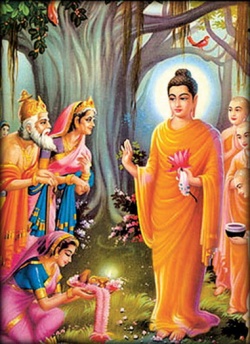Four teachings of doctrine
four teachings of doctrine
化法の四教 (Jpn keho-no-shikyo )
Also, four teachings. A classification by T'ient'ai (538-597) of Shakyamuni Buddha's teachings according to their content. Together with the four teachings of method, a classification by method of preaching, it constitutes the system of classification called the eight teachings. The four teachings of doctrine are:
(1) The Tripitaka teaching, which consists of the three divisions of the Buddhist canon—sutras, vinaya, or rules of monastic discipline, and abhidharma, or doctrinal treatises and commentaries and corresponds to the Hinayana, or pre-Mahayana, teachings. Teachings of this category aim to awaken people to the sufferings of birth and death in the threefold world and urge practitioners to rid themselves of earthly desires in order to escape the cycle of rebirth.
(2) The connecting teaching, or introductory Mahayana, which forms a link between the Tripitaka teachings and the later, more sophisticated, Mahayana teachings. Teachings of this category stress the perception of the nonsubstantiality of all things, or that nothing has an independent existence of its own, in order to eliminate illusions. While the Tripitaka teaching is addressed to voice-hearers and cause-awakened ones and the specific teaching to bodhisattvas, the connecting teaching is addressed to all of them.
(3) The specific teaching, a higher level of Mahayana addressed specifically to bodhisattvas, which enumerates the fifty-two stages of bodhisattva practice spanning innumerable kalpas. The teachings of this category reveal the three truths of nonsubstantiality, temporary existence, and the Middle Way, but show them as separate from and independent of one another.
(4) The perfect teaching, which expounds the mutually inclusive relationship of the ultimate truth and all phenomena, as well as the unification of the three truths. It reveals that all people have the potential for Buddhahood, and that they can attain enlightenment through the perception of the unification of the three truths. The perfect teaching is further subdivided into two: the perfect teaching of the sutras expounded before the Lotus Sutra, and the perfect teaching of the Lotus Sutra, or the sutra itself. Both teach that one can attain Buddhahood as an ordinary person, but the former, unlike the Lotus Sutra, does not show the way to achieve it. The full expression of the perfect teaching is found only in the Lotus Sutra.In The Profound Meaning of the Lotus Sutra, T'ient'ai defined the relationship between the four teachings of doctrine and the first four of the five periods with the terms "combining, excluding, corresponding, and including." These terms also describe the characteristics of the various sutras that came before the Lotus Sutra, and differentiate between them and the Lotus Sutra. The Flower Garland period combines the specific teaching with the perfect teaching ("combining"). The Agama period consists of the Tripitaka teaching only and excludes the connecting, specific, and perfect teachings ("excluding"). In the Correct and Equal period, all four teachings were taught in a manner corresponding to the people's capacity ("corresponding"). The Wisdom period consists of the perfect teaching, but includes the connecting and specific teachings ("including"). The purpose of clarifying these relationships is to show that the Lotus Sutra alone is the pure and perfect teaching, or the perfect teaching in the true sense of the term.
